 Recent studies have questioned the effectiveness of static stretching for performance and flexibility – do you believe this to be accurate and does static stretching still have a place in a runner’s program?
Recent studies have questioned the effectiveness of static stretching for performance and flexibility – do you believe this to be accurate and does static stretching still have a place in a runner’s program?
For years there has been an ongoing debate about the effectiveness of static stretching as preparation for physical activity. The reason for this debate is that some studies have found benefit from static stretching, while some research suggests it may inhibit performance and increase the risk of injury. From my experience it is very dependant on the athlete, and the type of exercise they are planning to engage in. For runners there are key areas where flexibility is imperative, and if you do not have the range of motion in these areas then stretching can be very beneficial in both improving performance and reducing the risk of injury. A good place to start is by ensuring that you have enough ankle dorsiflexion, and hip extension. The images below show the basic tests for these movements. To maintain good running form it is recommended you maintain 10 degrees of hip extension availability, and you are able to achieve 13cm on your ankle dorsiflexion knee to wall test.


How important is strength training for a long distance runner?
Strength is arguably more important than stretching when it comes to running. The forces going through your joints are 250% of your body weight when you jog, and even higher (>400%) when sprinting. To be able to withstand these forces you need a combination of foot, ankle, knee, hip, and core strength. The research suggests that “30-50% of runners will suffer an injury over the course of 12 months”, this is a scary statistic, and the main cause is a lack of running related strength. The 2 best ways to work on your running related strength is:
- Do specific gym exercises that focus on your running propulsion muscles (especially the claves)
- Build your running up slowly so that your body has time to adapt. Stick to the 10% rule and don’t increase you total weekly kilometres by >10% each week
How do you know when to prioritise strength or mobility/stretching?
“A tight muscle is a weak muscle” and for runners the need to stretch often implies as need to strengthen. The easiest way to know if an area needs strengthening is to do some strength tests with a trainer or physiotherapist, but for an easy test at home you should be able to do 30x single leg calf raises on each leg, with no rest. This is the minimum strength to be safe to run 5km regularly (>3 times a week). If your hip extension or ankle mobility are poor then the priority is to stretch these, and restore mobility, before you run. If these areas continually get tight then it’s a strong suggestion that they may need strengthening.
Myles can be found at Activate Health and Fitness as well as at our home at The Fitness Specialists in Milton. Get in contact via myles@activatehf.com.au.
Stay in shape this winter (and beyond) by incorporating some our favourites exercises we use in our programming. Some are conventional lifts, while others are variations on classics. Some will be more strength focused, while others will dial up your heart rate. Either way, start doing them now! Here we go:
1. The landmine clean and press.
An advanced full body movement focusing on power, The landmine clean and press is the perfect exercise to throw into a conditioning circuit given the amount of muscles you are working. The added rotational component makes this a go to of ours.
Once you’ve got the flow of the movement, it is actually much easier than it looks. Break it down by practising the following on the landmine attachment:
- Single arm high pull.
- .The pivoting of your feet by 90 degrees while changing the bar between your hands.
- A single arm press.
Note: A landmine exercise refers to an angled barbell movement where one end of the barbell is on the ground (either in an attachment such as above or safely wedged into a corner of a wall/something stable).
2. The forward to reverse lunge
With added volume compared to a traditional lunge, this variation targets the quads and glutes from two different angles, and really ups your heart rate! You don’t need to add much weight to feel this lunge variation in all it’s glory. Try to go from the forward direction to reverse without your foot touching the ground in between for balance. Regarding technique, practice the following:
- On the forward lunge, keep your spine in a straight line perpendicular with the ground.
- On the reverse lunge, hinge/tilt forward at the hips more while maintaining a straight back.
- Aim for at least 6 reps on each side (forward to reverse = 1 rep).
3. The trap bar deadlift
If you’ve been following us for a while you’ll know we love deadlifting and we will always recommend the movement, but in this case we are going to recommend the trap bar variation over the barbell for a number of reasons.
Both the barbell and trap bar deadlift help to increase hip mobility and increase strength through the posterior chain (lower and upper back, glutes, hamstring muscles), however the trap bar has less of a load on your spine due the torso being more upright. It could be a good starting point if you lack control and stability through your lower back. The neutral grip positioning of your hands (palms facing towards your body) are also much easier in terms of shoulder stability.
4. Pull Ups
Executing a pull up from a full hanging position is one of the toughest upper body exercises you can do, and requires plenty of strength through your upper back muscles, shoulders, and biceps.
Brace the glutes, keep the core tight, and envision pulling the bar towards your chest. As fitness expert and strength coach Bret Contreas says, think of the pull up/chin up as a moving plank and keep a straight line from the shoulders to the knees throughout the movement. Vary your grips and hand spacing to help improve your performance.
Also, your lats (upper back muscles which run from your shoulders to your hips) are one of the primary muscles being used in a pull up, and are key muscles of your core so strengthening them can assist in improving your squat and deadlift.
5. Goblet Squats
A much more natural squat position in comparison to a front and back squat, the goblet squat should be the starting point for all weighted squats as it allows you to set a rigid spine and perfect the balance and movement of a squat. As well as a starting point, there are benefits to programming variations of the goblet squats for people of all levels.
The goblet squat will help you improve the upright torso position that is needed for more advanced exercises (such as cleans, front and back barbell squats, amongst others), as well as being a great exercise for the quads, core, and upper back. Due to the upright torso position, this also allows for less stress through your lower back.
James
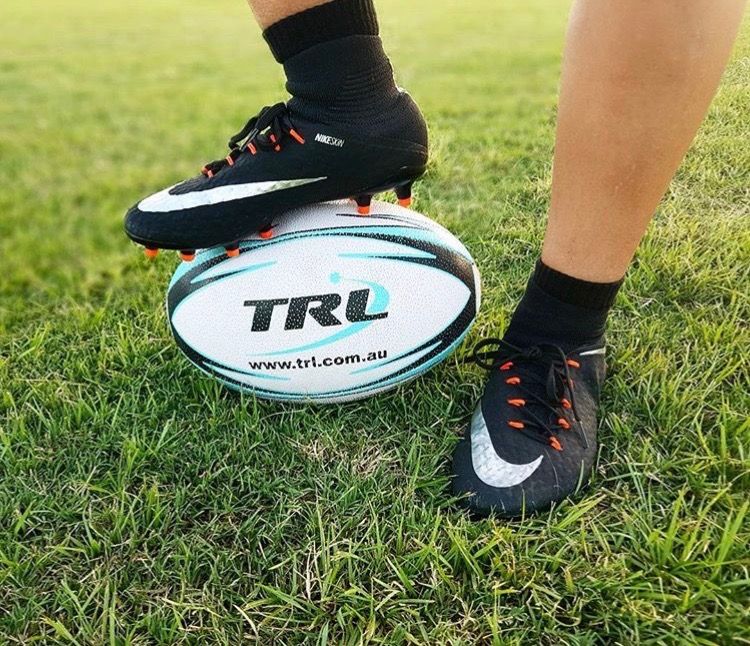 Whilst strength training sets the foundation for fitness, doing so in a gym or with a personal trainer is not the only physical activity you should do to stay healthy, but rather should be part of a wider active lifestyle. Making physical activity an easy part of your daily routine – like cycling on your commute to and from work, for example – or taking it up as a social activity – like weekend hikes or playing a social sport – should also be considered as part of this active lifestyle.
Whilst strength training sets the foundation for fitness, doing so in a gym or with a personal trainer is not the only physical activity you should do to stay healthy, but rather should be part of a wider active lifestyle. Making physical activity an easy part of your daily routine – like cycling on your commute to and from work, for example – or taking it up as a social activity – like weekend hikes or playing a social sport – should also be considered as part of this active lifestyle.
When it comes to social sport, combining fitness with socialising with friends or work colleagues has its benefits both physically and mentally. Social sport gives your training schedule variety and also promotes social health by spending time with friends and meeting new people.
On a personal note, I have been playing Touch Rugby League (TRL) for a number of years as my social sporting competition of choice. More recently, I’ve started working more closely with TRL through JS-PT on corporate health programs as an addition to group training sessions.
To speak more about the benefits of playing social sport and playing TRL in particular, we invited Chairman of TRL Tom Longworth to feature in this month’s JS-PT news:
Touch Rugby League (TRL) was founded in 2005 and has always been a social-sport at heart. Whilst we do offer very competitive and elite pathways, at the heart of our offering is providing teams the chance to exercise and get fit, but in a social context. TRL provides a great opportunity for people to meet others and has been an avenue through which thousands of Corporate teams have built upon team spirit and camaraderie.
Whilst physical health is important, so is mental health and a big part of that is maintaining healthy relationships with friends, family and work colleagues. In reality, we all spend more time with work colleagues than just about anyone so being able to relate to one another in a work context, and to have a strong bond (built on trust and respect) plays a key role in mental health.
TRL provides a great opportunity for people to engage, to develop a sense of trust, respect and teamwork on the field all whilst having fun and of course keeping fit. Strong relationships make for a better workplace.
With multiple locations across Brisbane (and Australia), it has always been straight forward finding competitions to enter, and also has helped me implement more cardiovascular training into my week! For more information on any of the above, please feel free to contact Tom directly by emailing tom@trl.com.au or by visiting the website.
Until next time,
James
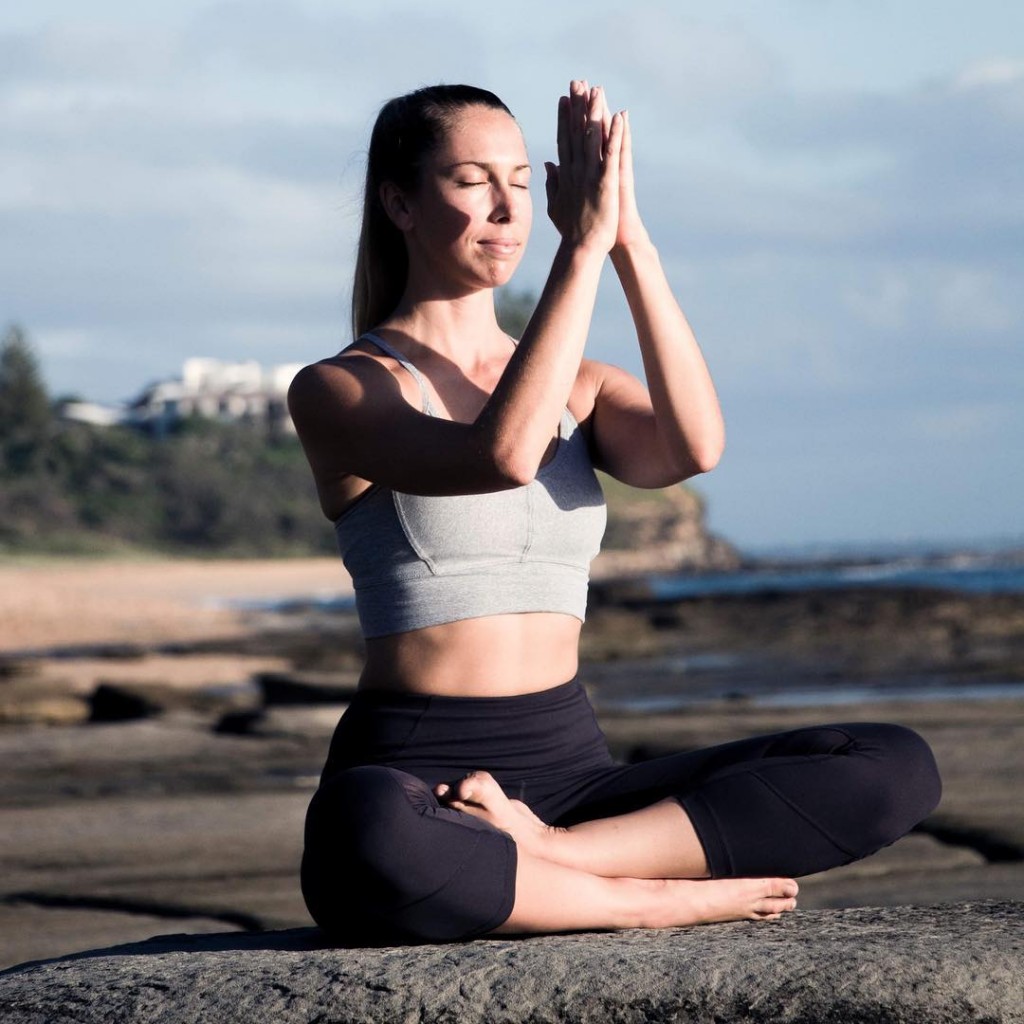
Are you working long hours and often hunched over a computer? Are you racing to and from back-to-back meetings whilst trying not to think about how you will manage the mass amount of emails coming in? Are you feeling stressed and rundown by the increasing demand on employees? As a fellow corporate professional I truly understand how close to home these are working in the corporate world. I have seen firsthand how gradually these detrimental work habits begin to take a toll on our bodies and minds in the form of stress, tension and sickness. Whilst a mild amount of stress can help us meet deadlines, too much or constant stress can have a significant impact on our overall wellbeing. We spend over one-third of our life at work, that’s why it’s so important that we introduce tools early to help us better handle workplace stress and improve our overall wellbeing in the corporate world.
One of these great tools I have found is Yoga. I’m sure you’ve heard of Yoga, but you may be wondering how turning yourself into a pretzel is going to help you in the workplace? Fair question, so let’s break this down.
Why Yoga?
Everyone has different triggers and reactions to stress and in today’s world, stress is inescapable. The good news is you can develop ways to handle stress through Yoga principles. Numerous studies have shown how Yoga can help to counterbalance the body’s physical, mental and emotional reactions to stress. Yoga is more than merely a physical practice and another element of yoga that is becoming increasingly common in the western world is meditation. Yoga not only assists in the daily pressures placed on the physical body, it can also positively affect your mental and emotional wellbeing through meditation and mindful practices.
You don’t have to be an advanced yogi to learn and apply these tools, so let’s have a look at three quick practices you can implement to better handle stress and improve your overall wellbeing in the workplace.
Desk Yoga
It’s not news that we’re all spending more time hunched over our desks creating tight hips and shoulders, a creaky neck and sore back. All the usual consequences of slouching at your desk for 8 hours a day. Sitting for prolonged periods of time can lead to imbalances in your body that cause poor posture and injury down the road. Yoga can help reduce discomfort and target areas of tension, being an effective way to counterbalance common physical ailments.
I’ve suggested 6 quick and effective stretches you can do at your desk in less than 5 minutes. If you need a visual, google these names for the image of the stretch:
• Seated neck stretch
• Wrist stretch and release
• Seated chair twist
• Desk shoulder opener
• Chair hip opener
• Standing forward fold
Taking some time in your workday to perform these quick stretches might just save you a more expensive trip to the physio!
Mindful breaks
In a world where busyness can be perceived as success, taking a lunch break can sometimes be frowned upon. However, what you do in your lunch break can have a huge impact on your productivity for the rest of the day.
Eating at your desk or spending your break aimlessly scrolling through social media can leave you feeling not very refreshed. Productivity reduces, it’s harder to focus and you may need that extra dose of caffeine to get you through.
So maybe step away from your desk and try a few of these:
• Take a walk around the block without looking at your phone. Really notice what’s going on around you and take in the fresh air.
• Eat your lunch mindfully. Take some time to appreciate the flavor and texture rather than rushing to eat while checking social media.
• Practice some mindful meditation in your break, deep breathing and paying attention to how you’re feeling.
Taking a deliberate break from work with a short walk or a bit of mindful relaxation can have powerful effects on our end-of-day concentration, stress, and fatigue.
Meditation
Research on meditation has shown it has many benefits, such as easing stress and anxiety and inducing feelings of tranquility and calmness. While the body needs constant movement to be healthy, the mind thrives with regular doses of stillness.
Our minds like to be busy to help us accomplish tasks, however this can also cause us stress and lack of focus. The good news is, we can train our minds to be calmer and more focused through the practice of meditation. Spending just 5 minutes in meditation can completely change the way you approach life and how your body responds to stress.
More popularly of late, the western world has been referring to ‘Mindfulness Meditation’. Here’s some quick tools as to how you can implement a 5-minute mindfulness meditation in your day. So set an alarm, and let’s get started.
• Find a comfortable position and close your eyes
• Feel which parts of your body connect to the floor
• Draw your attention to your natural breath, becoming aware of the sensation of each inhale and exhale
• Inevitably, your mind may wander, if it does, draw your attention back to the breath
• Notice the sounds around you
• Notice the temperature of the air on your skin
• If your mind gets carried away in thought, return your focus again to the breath
• When you’re 5 minutes concludes, gently open your eyes and notice what’s around you; colours, objects, people
• Pause for a moment and notice how you feel before continuing your day
There you have it, that’s it! Simple, quick and effective.
The practice involves training your mind to focus and be in the present moment without drifting into concerns about the past or future, which is where stress and anxiety can arise. Like any exercise, consistency is key. Give it a try next time you are standing in line, before a meeting, or anytime you need to regroup and have a moment of downtime. With regular practice, mindfulness meditation may also assist you in:
• Remaining calm under pressure
• Improving focus, attention and productivity
• Making decisions from a calm and grounded place
• Re-energise and clear your mind
• Experience less stress and anxiety
• A sense of connection
• Improved sleep
I hope you enjoy these tips on how you can easily implement yogic principles into your corporate day to better handle stress and improve your overall wellbeing. Like everything, start small and be kind to yourself, but most importantly, make a commitment to yourself as changes don’t happen overnight.
Sending calming vibes your way.
Diane Jeays
From Corporate Yogini (@coporate.yogini on Instagram)
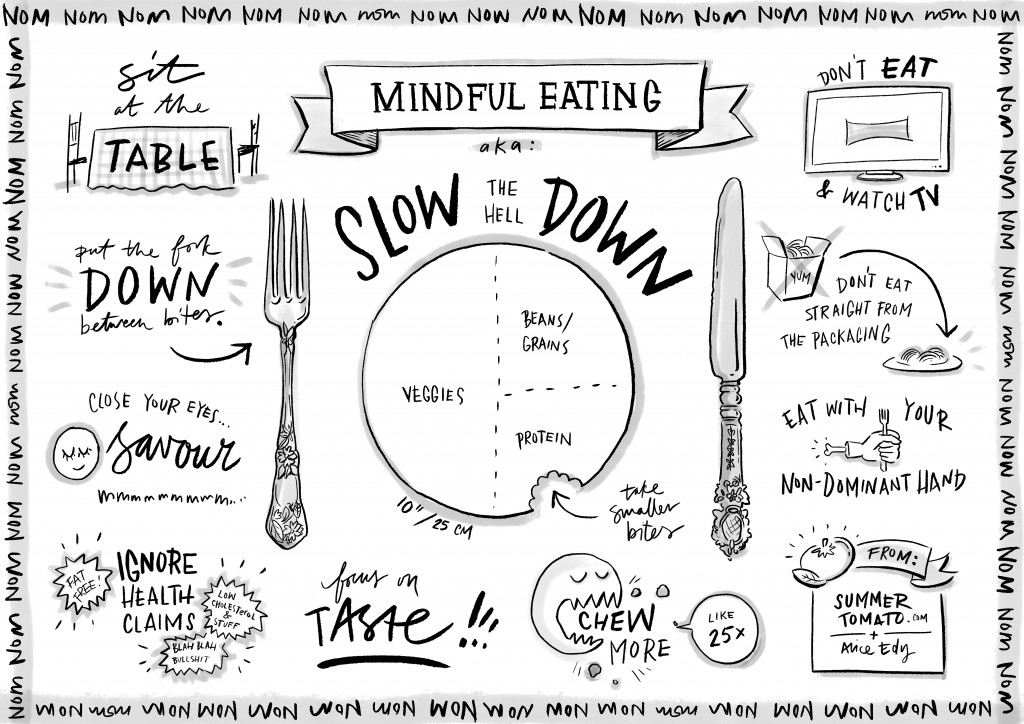
Mindful Eating – I’m sure you’ve heard the term, but do you feel like you’ve really grasped the concept? These days the term ‘Mindful Eating’ has somehow found its way into diet and weight loss programs around the world. Yet using mindful eating as as weight loss tool actually goes against what the practice of what mindful eating is truly about. Let’s break this down.
So what is Mindfulness?
Mindfulness is all about deliberately paying attention, non – judgmentally to your thoughts, emotions and physical sensations in the present moment. It’is purpose is to help free yourself of reactive, habitual patterns of thinking, feeling and acting. It is about balance, choice, wisdom and acceptance of what is.
Ok, so how does Mindful Eating fit in?
Mindful eating involves the act of non-judgmentally acknowledging your hunger and fullness cues to guide your decisions of when to begin and finish eating foods, and eating with awareness of all of your senses – sight, sound, touch, taste and smell. It helps to develop non-judgemental responses to food (likes, dislikes, neutral) while allowing yourself to become aware of the positive and nurturing opportunities available through food selection and preparation. It is a tool to learn which foods will best satisfy your hunger.
Why is it not for weight loss?
As you can see, the core purpose of mindful eating is to eat without judgement guided by your internal hunger and fullness cues. Practicing mindful eating with the intention to lose weight means that you are entering the eating occasion with expectation and judgement – to lose weight. If those expectations aren’t met, generally feelings of failure arise – which more often than not lead back to partaking in another behaviour for weight loss – which is a classic example of the diet cycle.
So how can Mindful eating help?
Eating is a behaviour and behaviour change is hard! You can follow a meal plan or pay someone to dictate to you what to eat until they are blue in the face, but at the end of day you have to learn to eat for YOU. Improving your eating behaviours is not about weighing less for a moment in time, but about learning to eat well for the rest of your life. Mindful eating can assist this in this in a number of ways:
• Reconnecting with internal physical hunger and fullness cues: We were all born with the ability to regulate our hunger and fullness internally, but as we get older and life gets busier these cues get interrupted by our environment (i.e. increased stress, working shift work, designated eating times, being preoccupied with work,). By bringing awareness to your body’s sensations around hunger and fullness, mindful eating can help you reconnect with this innate ability we are all born with.
• Reduce Non – Hungry Eating: As natural cues to hunger and fullness are explored mindful eating can help you to identify any instances of non hungry eating (i.e. eating because you are bored, stressed, depressed, lonely, procrastinating or just because it is there). Recognising these occasions is the first step to behaviour change and allows you to explore other remedies for non-hungry eating than food.
• Reduce Overeating: Awareness during eating is also key to mindfulness practice. Combined with hunger-fullness awareness this allows us to notice when a food ceases to be as palatable or as enjoyable, helping to determine when satisfaction has been reached. This is called the ‘Law of Diminishing Pleasure’.
• Increase confidence around foods we feel powerless around: We all have them, those foods that we don’t keep in the house because we don’t trust ourselves around them. Avoidance is a short term solution but long term it’s important to feel confident that you can be around certain foods without going crazy. When eating for ‘pleasure’ over ‘fuel’ – which is totally ok to do, practicing mindful eating can help us to determine when our pleasure/sensory needs have been fulfilled. For example you may buy a chocolate bar because you genuinely feel like it – in the past you might eat the whole bar because it is there, using mindful eating you may find that just half the bar satisfies you – or you may not! Only you can determine this.
How can I be a more a mindful eater? Here are 5 ways you can start with now:
- Write a definition of your hunger as if you were to put it in a dictionary- i.e. I feel… an empty feeling, gnawing and… fatigued, moody.
- Keep a hunger diary- Note down times you get hungry and any relevant circumstances around your hunger. Are you hungrier on days you exercise? Or perhaps days you have a larger workload? Less hungry on days you are stressed? Identifying patterns can help you to pack, prepare and choose foods that are more likely to satisfy your hunger.
- Give your hunger and fullness a score / 10- this is best practiced around meals you feel your overeat at (See scale below). Try to identify how much you need to stay in the comfort zone (i.e not getting so hungry you bite someone’s head off, and not getting so full that you feel unwell).
- Eat without distractions- Turn off the TV and put down the phone. Save your attention for the eating experience!
- Be curious with food, even if you have had it a million times- Before taking the first bite, ask yourself; What is the colour, texture and shape of your food like? Does it feel warm, cold or neutral? What does it smell like? Does it smell as you expected? Do different parts of it look, feel or smell different? Take a bite, but don’t chew yet! Is it cold, warm or hot on your tongue? How does the texture feel? Is it soft, smooth, dry or hard? Is it a combination? Chew slowly…How does it taste? Is is sweet, salty, or a mixture of both? Does the texture change as you chew? Does the flavour change as you chew? How does it feel on your tongue as you move it around your mouth? Now swallow…Has the taste changed again? Are there bits in your teeth? What is the aftertaste like? How is it similar or different from your first chew? Do you need more or are you satisfied?
I hope you enjoy these tips on mindful eating and remember – mindful eating is about eating without judgement and is a skill that takes practice. Start small – if you can only practise mindfulness at one meal this week that’s ok, be patient with yourself – remember behaviour change is hard.
For more on mindful eating, why not visit the Centre for Mindful Eating at www.tcme.org
Serena Sullivan
I: @gathernutrition
F: Gather Nutrition and Dietetics
W: www.gathernutritionaustralia.com
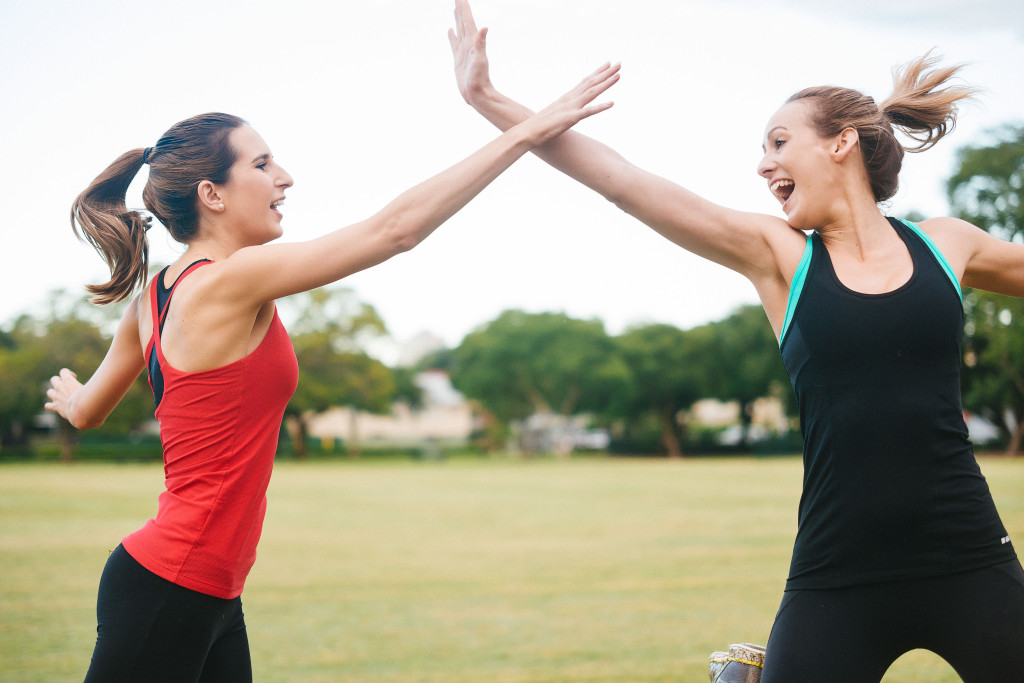
As the mornings become cooler and the daylight hours decrease, motivation for exercise before and after work can begin to diminish as it competes with extra sleep in a warm bed or a hot meal sooner in the evening. Sure you have that weight to lose, but what harm will missing one day really have? Well, these missed days tend to accumulate more when the weather is cooler and before you know it, your consistent routine is something of the past. Often in life, you need another person to inspire motivation, and exercise is no different.
Even if you are seeing a personal trainer for motivation, sometimes you need a little bit more. That little bit more comes in the form of a training partner. Whether it is your husband or wife, boyfriend or girlfriend, family member or best friend, training with someone else both in and outside of your PT sessions can be of great benefit to you. Some of the reasons include:
1. You’ll miss fewer sessions. When your motivation is lacking, you have someone else to answer to now. Cancelling is one thing, but you won’t want to cancel on a friend or your partner!
2. You’ll work harder. No one wants to be that person holding back the team. Training with someone else will push you to reach a higher intensity. You can also encourage each other throughout the workout.
3. Your bank account will thank you. When two people are training with a PT, you split the costs. This is a great way to receive extra attention to detail that a trainer can give you versus a busy boot camp.
At JS-PT, the most common 2-on-1 sessions are couples training together, however more friends are enquiring and starting these types of sessions due to the financial benefit. An extra benefit with the JS-PT 2-on-1 sessions is the option of training in a gym of which has no membership payment required, or training outdoors. Now keep your exercise frequency and consistency this autumn and winter, and find someone to start exercising with!
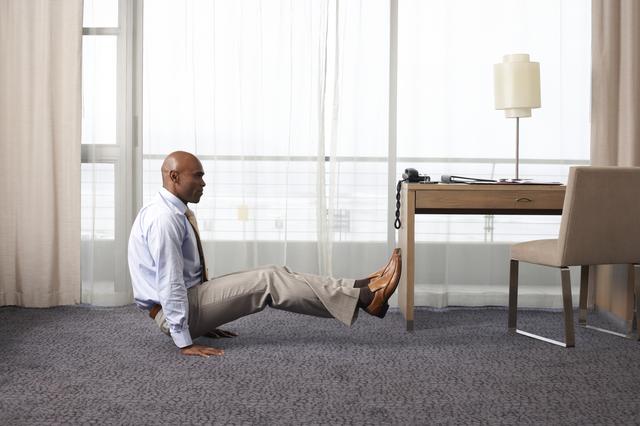
You can have the best nutrition plan in the world, but if your compliance to the plan is low, your results will be minimal. Those that travel for work often know all about the challenge of remaining compliant with their plan, and even those that travel occasionally can relate. If you fall into this category, then the following strategies will help you increase your adherence to a nutrition plan.
Choosing the best location
Whether you’re away for a conference for a couple of nights or working in an interstate office for the week, your first priority should be location. Not just in relation to where your work commitments are, but how close are you to supermarkets/gyms/restaurants from your hotel? Are you within walking distance? Without these type of places being close, it’s easy to make poor selections.
Choosing a room with kitchenette
Price is an obvious factor here, but a room with a kitchenette or even just a fridge, you can stock the room with healthy snacks/meals such as fresh fruit and vegetables, yoghurts, breads, sliced chicken/turkey, milk, bottled water etc.
Research restaurant menus in advance
If you intend on eating out, hop onto the websites of the possible restaurants where you intend on eating so you know what could potentially fit into your plan.
Bring protein supplements
Often the biggest challenge for people who travel often (even those who don’t) is maintaining adequate amounts of protein. If you are using the above strategies then you should be doing well to maintain sensible eating patterns, but bringing your own protein powder down is a good and quick fall back option if you aren’t able to eat as well as you would like.
While these are pretty simple steps to take when travelling, sometimes it is easier said than done to be compliant with a good eating plan. Put into place these strategies and help increase the likelihood of you remaining on track with your nutrition goals.
Inspired by Precision Nutrition

Christmas. One of my favourite times of the year in terms of eating… Fresh seafood, food hampers, trifles, champagne; the list could go on. It’s also a time when all that eating and drinking results in some unwanted weight gain, as I’m sure you’ve experienced during festive periods in years gone by.
While overeating will feel an inevitable outcome for some (although they are willing to accept the consequences), others can feel overwhelmed with guilt after the new year rolls in knowing they jumped off the wagon. To limit the overall damage both physically and mentally, I’ve compiled 5 tips which will help you indulge and enjoy a festive, guilt free Christmas.
1. Accept the fact you will likely consume more.
I’ve seen plenty of strategies online with the aim of ‘limiting the damage’ over Christmas with tips such as saying no to dessert, limit carbs, and a whole lot of other restrictive crap to ensure you stay within your calorie goals. That’s definitely not what you are about to read. Accept the fact that during this period you will attend parties, you will have big dinners and lunches, and you will have plenty of left overs. Cherish this time you will spend with your family and friends, be mindful of what’s enough to eat, and don’t stress about calories! The sooner you can accept that and not be so hard on yourself, the less guilty you will feel.
2. It’s OK to skip meals.
Christmas lunch with my family is my favourite meal of the year, and I’m sure many of you reading will feel the same way about your Christmas Day meals. Due to the amount of food I know I will be eating, usually I’ll skip breakfast beforehand to save room. This type of strategy could be used at anytime during the year, when you know you’re about to over-indulge, or when you unexpectedly over-indulge. Balance yourself out by eating smaller meals before or after if you need to.
3. Make better bad choices.
This is pretty straight forward. Just because you’re eating more than you normally do, doesn’t mean you need to completely blow your intake out of the water and consume as much as you can. That’s just silly. By all means enjoy what there is on offer, but you know when you’re full.
4. Keep moving.
As hectic as this period can be, try and schedule some activity in during those few weeks. I’m not saying you must go to the gym everyday, but it would be beneficial to keep yourself active to some extent, even if it was just walking along the beach or doing shorter workouts throughout your break.
5. Do the above and simply enjoy your break!
Enjoy the time you spend with your family, enjoy seeing your friends, enjoy the functions you attend with your work colleagues, and enjoy the fact you have a couple of weeks to do whatever you want! Keep up points 1 to 4 and you should be able to relax and enjoy everything that Christmas and New Year’s brings.
—
Take the above tips into consideration before the festive break, and you should feel in a good physical and mental state come the new year.
From the JS-PT team, have a very Merry Christmas and wonderful New Year! See you in 2015.
 Recent studies have questioned the effectiveness of static stretching for performance and flexibility – do you believe this to be accurate and does static stretching still have a place in a runner’s program?
Recent studies have questioned the effectiveness of static stretching for performance and flexibility – do you believe this to be accurate and does static stretching still have a place in a runner’s program? 







